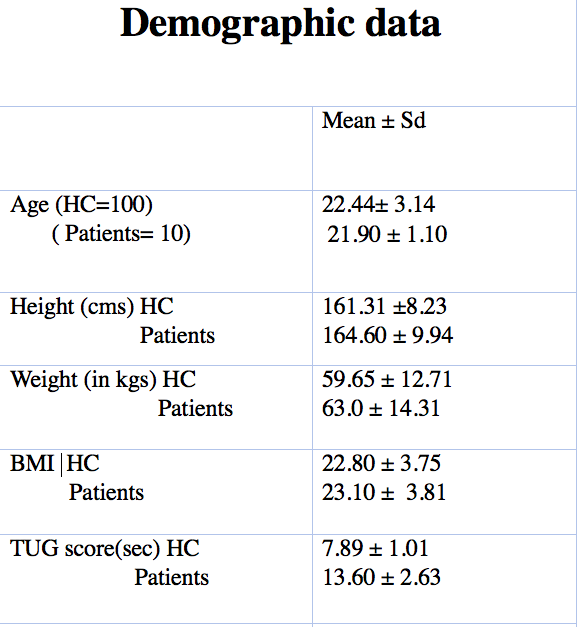Session Information
Date: Monday, September 23, 2019
Session Title: Ataxia
Session Time: 1:45pm-3:15pm
Location: Les Muses, Level 3
Objective: This study investigated the clinical usefulness of the time up and go test in young population and provide a reference range for healthy adults. The study also compared the performance of young adults with cerebellar ataxia on TUG test.
Background: The time up and go test is a mobility test that assesses balance and gait in a functional activity used in everyday life. The time up and go test, “standardizes most of the basic mobility manoeuvres, yet is quick and practical”. TUG test closely relates to an individual’s independence for basic transfers. TUG has been shown to be a useful measure of balance, gait speed, and function. According to a Delphi survey(2015) TUG is a recommended outcome measure in Cerebellar Ataxia. Since Physical therapy intervention is the mainstay for gait ataxia and imbalance in individuals with cerebellar damage, hence use of standardised and validated tools for the specific population becomes imperative.However there is a paucity of normative reference range of TUG from Indian subcontinent.
Method: Inclusion criteria:A total of 100 College students aged between 17 to 35 years and 10 patients with cerebellar ataxia were recruited through convenient sampling.Cooperative with functional vision and hearing, No medication, Impedance in ambulation, those who obey verbal commands. Exclusion criteria:History of fracture and musculoskeletal deformities within 6 months, History of severe cardiovascular respiratory disorders. Methods: After anthropometric measurement, all subjects performed test by standard procedure consisting of rising from a chair positioned 3m from a wall, walking 3m, turning around, returning to the chair, and sitting down again. The verbal command included instructions about velocity such as: ‘walk at your normal pace”. Data was checked for normality and then statistically analyzed using Pearson’s Correlation Coefficient test. Level of significance was set at P < 0.05.
Results: The mean score of the TUG in the healthy group was 7.89 ± 1.01 sec and in patient group was 13.60 ± 2.63 ; There was a weak correlation of TUG with the anthropometric characteristics in the groups.
Conclusion: This study provides clinical reference value for young Indian population for TUG test, while anthropometrics do not affect performance in younger age group.
References: Winser SJ, Smith C, Hale LA, Claydon LS, Whitney SL.Balance outcome measures in cerebellar ataxia: a Delphi survey.Disabil Rehabil. 2015;37(2):165-70. Keller JL, Bastian AJ.A home balance exercise program improves walking in people with cerebellar ataxia.Neurorehabil Neural Repair. 2014 Oct;28(8):770-8.
To cite this abstract in AMA style:
D. Kaur, K. Umakant, T. Aziz, P. Jaiswal, M. Kumari, A. Gupta, G. Kumar. Normative Reference for Timed Up and Go Test (TUG) in Young Indian Adults- Preliminary Results [abstract]. Mov Disord. 2019; 34 (suppl 2). https://www.mdsabstracts.org/abstract/normative-reference-for-timed-up-and-go-test-tug-in-young-indian-adults-preliminary-results/. Accessed December 31, 2025.« Back to 2019 International Congress
MDS Abstracts - https://www.mdsabstracts.org/abstract/normative-reference-for-timed-up-and-go-test-tug-in-young-indian-adults-preliminary-results/

